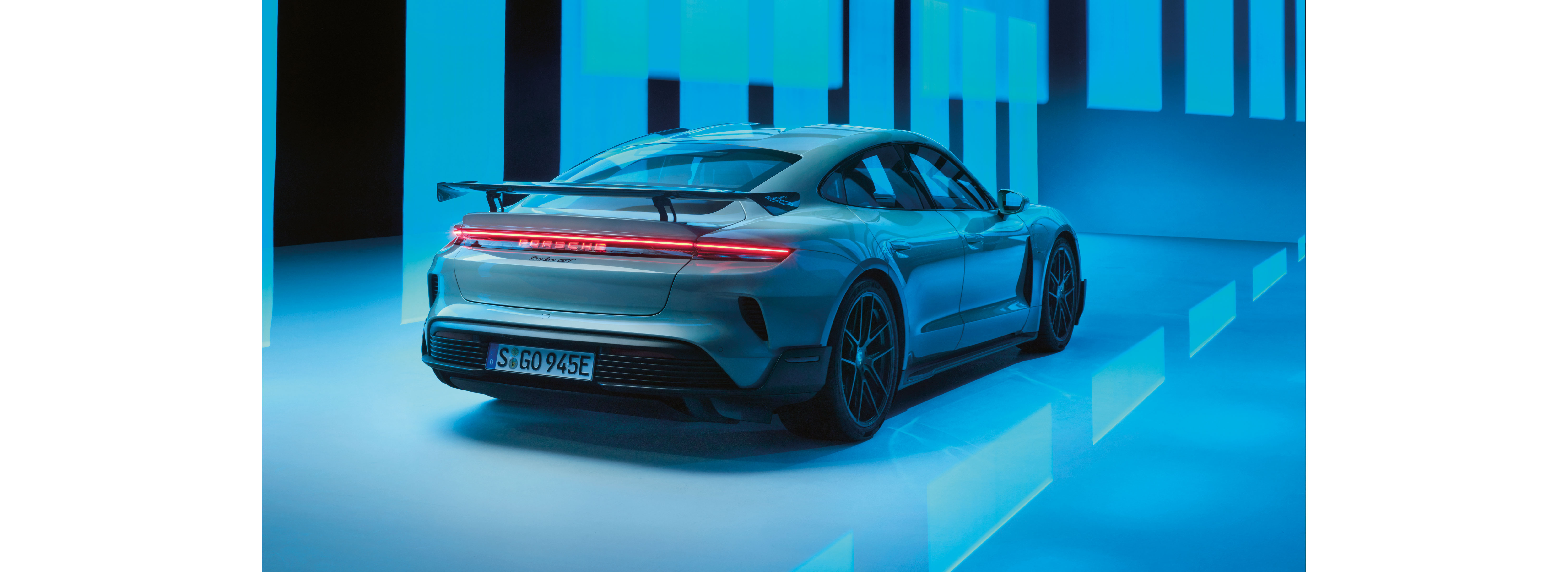What Makes the Taycan Turbo GT the Most Powerful Production Porsche?
A current of 900 amperes delivers so much more electric energy to the electric motor at the rear axle than ever before. That and many other optimizations allow the Taycan Turbo GT to achieve top speeds.
Pulsing with electricity, the new Taycan Turbo GT is the most powerful production Porsche of its time. The sports sedan with an unwavering focus on performance far exceeds the other top performers in the all-electric model range. The Taycan Turbo S, which delivers up to 700 kW (952 PS; Taycan Turbo S: Electric power consumption* combined (WLTP) 20.0 – 17.8 kWh/100 km, CO₂ emissions* combined (WLTP) 0 g/km, CO₂ class A ), is itself considered to be an extraordinary powerhouse.
“We’ve come to realize that some of our customers are looking for a top model with an even higher position,” explains Christian Müller, who as Technical Project Manager at Porsche is in charge of special vehicles in the Taycan series. “An increase in power is one of the key components of a derivate developed for high performance, which is why we focused on that at a very early stage of development.”
Up to 115 kW (156 PS; Taycan Turbo GT: Electric power consumption* combined (WLTP) 21.2 – 20.5 kWh/100 km, CO₂ emissions* combined (WLTP) 0 g/km, CO₂ class A ) more thrust can be obtained for a maximum of two seconds, compared to the Turbo S: How can this be achieved for an electric drive? When it comes to gasoline engines like the traditional six-cylinder boxer, these concepts are well known for providing boosts in power – with more displacement, higher revolutions, and lower friction losses. Or even charging with turbo technology. But things look completely different for electric motors.

For Müller and his team, their focus first turned to the electric drive system’s pulse inverter at the rear axle – the component that converts the direct voltage of the 105 kWh high-voltage battery into alternating voltage and controls the electric motor. In the Taycan Turbo S, an inverter with 600 amperes (A) is installed there. The new component of the Turbo GT works with a current of up to 900 A and therefore pushes more electric energy toward the electric motor, much like a more powerful pump. At the same time, silicon carbide is used as a semiconduc-tor material in the inverter in place of silicon, thus reducing switching losses and increasing pulse frequency. The result is vastly improved efficiency and the associated higher consistency in performance. “That’s the most important development right now,” emphasizes Müller.
As simple as these measures may sound, they’re not that simple to implement. “The new pulse inverter is taller than before, so we had to modify the body shell to enable integration,” says Müller. “As a result, a sort of ‘power dome’ was created between the wheel arches in the trunk, which we used as an attractive storage compartment and enhanced with ‘Turbo GT’ lettering.”
The permanent synchronous motor and the new pulse inverter were optimally adapted for use with the higher 900 A current, which delivers extraordinary power even at high speeds, ensuring the typical Porsche performance. Porsche experts also devoted a great deal of time to the two-speed transmission at the rear axle. “The higher input torque increases the level of stress, which is why we made the transmission components more robust – for example, with the specially treated surfaces of the gear pairs, adapted bearings, and a stronger clutch,” says Christian Müller. The engineers were able to do all of that in the installation space of the existing transmission housing, which was also reinforced. “There’s also the fact that the ratio is now longer, which has allowed us to achieve the much higher top track speed of 305 kmh and for which the front axle drive was overhauled.”

Extraordinary performance:
When Launch Control with Overboost function is activated, the Taycan Turbo GT has a power output of 815 kW (1,108 PS) for a maximum of two seconds. In Attack Mode, the electric sports car delivers power of 700 kW (952 PS) for ten seconds.Especially when it comes to a high-performance sports car like the Taycan Turbo GT, it’s only the sum of all the measures that creates a consistent overall appearance. This begins with the specially adapted aerodynamics featuring a modified underbody and a new front and rear spoiler, and extends to the lightweight ceramic brakes, the special high-performance summer tires on exclusive 21-inch forged wheels, and additional intelligent lightweight features.
The Taycan Turbo GT with the austere Weissach package goes even further, dispensing with all of the equipment details that are superfluous for top performance on the track. Even the rear seats had to go. As a result, the Turbo GT with the Weissach package is 70 kilograms lighter than the model without.
The character unleashed by this comprehensive performance optimization is nothing short of spectacular. The extraordinary all-electric vehicle is able to maintain 580 kW (789 PS; Taycan Turbo GT with Weissach package: Electric power consumption* combined (WLTP) 20.8 – 20.6 kWh/100 km, CO₂ emissions* combined (WLTP) 0 g/km, CO₂ class A ). When the Turbo GT with Launch Control catapults out of the starting grid, 760 kW (1,034 PS) are available – and with Overboost power, output of 815 kW (1,108 PS) is available for a maximum of two seconds. The model with the Weissach package reaches 100 kmh in 2.2 seconds, which means it’s a tenth of a second faster than the equally powerful Taycan Turbo GT without the Weissach package. It only takes the two-seater 6.4 seconds to reach a speed of 200 kmh.

Hat trick:
In 2024, the Taycan Turbo GT with Weissach package broke three records on three continents. The electric sports car achieved best times at the Nürburgring Nordschleife, the WeatherTech Raceway Laguna Seca in California, and the Shanghai International Circuit.If the driver activates Attack Mode, additional power of up to 120 kW (163 PS) is available for ten seconds (prerequisite: battery charged to more than 30 percent, battery temperature more than ten degrees Celsius. At low temperatures, optimized availability in Sport and Sport Plus driving modes. Recommended for circuit use only). However, this power cannot be added to the 815 kW (1,108 PS), but can only be used outside of the Overboost function and Launch Control.
Christian Müller and his team derived this function from the Porsche 99X Electric used in Formula E. It’s available again after a break of four seconds. “This time restriction allows us to keep the thermal stress in check for the motor and battery,” explains the Technical Project Manager for special vehicles.
If you want to experience the full potential of the Taycan Turbo GT on the racecourse, you can prepare it accordingly with the racecourse mode. Then the high-performance sports car will bring the traction battery and drives to the optimal starting temperature, which for the Nürburgring Nordschleife, for example, is just under 13 degrees Celsius. Christian Müller laughs and says, “There’s no need to warm up the Taycan Turbo GT, which is traditionally recommended for sports cars with a conventional drive.”
Consumption data
911 GT3
Taycan Turbo GT
-
21.2 – 20.5 kWh/100 km
-
0 g/km
-
A Class
Taycan Turbo GT with Weissach package
-
20.8 – 20.6 kWh/100 km
-
0 g/km
-
A Class
Taycan Turbo S
-
20.0 – 17.8 kWh/100 km
-
0 g/km
-
A Class





